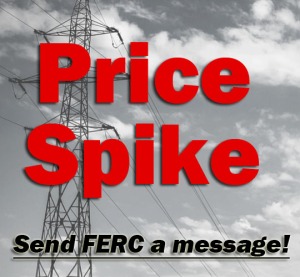
More than 3,000 messages were sent to FERC via the CUB Action Network asking the federal agency to launch an investigation of a price spike in Central and Southern Illinois. Now, the agency has begun a formal probe. Sign our petition asking FERC to reform the power markets.
Federal regulators have listened to Attorney General Lisa Madigan and more than 3,000 CUB Action Network members who called for an investigation of the electricity market in Central and Southern Illinois after consumers were hit with a 30 percent price spike.
Here are the developments since CUB held a media campaign calling for an investigation this past June.
Federal Energy Regulatory Commission (FERC) probe. As Crain’s Chicago Business reported, FERC has taken the unusual step of ordering a formal investigation into the results of an electricity auction last spring that sparked a 30 percent June 1 price spike. Crain’s reports that FERC on Oct. 1 gave its enforcement staff subpoena authority.
“This is just the beginning of the battle, but it’s a step in the right direction to reforming Illinois power markets,” CUB Executive Director David Kolata said. “When Illinois has a surplus of power and families still are hit with rate shock, something is wrong.”(Read CUB’s full-statement.)
FERC technical conference. Consumer advocates are gathering today (Oct. 20) for a technical conference in Washington, D.C., as FERC seeks more information on complaints filed by Illinois Attorney General Lisa Madigan and others in connection with the power price spike. It’s always a good step in the right direction when federal regulators want to discuss how to improve the power market.
New power prices as of Oct. 1. The price spike was bad enough that Ameren has taken the unusual step of implementing a two-tiered rate structure—to give high-usage customers (people using electric heat in the winter) a lower rate for any electricity use beyond 800 kilowatt-hour (kWh). Here are the new prices as of Oct. 1:
Ameren Zone 1:
6.776 cents per kilowatt-hour (kWh) for the first 800 kWh of power usage
4.679 cents per kWh for power used after the first 800 kWh
(Example: If you use 1,000 kWh of electricity in one month, you’ll be charged 6.776 cents per kWh for the first 800 kWh, and 4.679 cents per kWh for the additional 200 kWh.)
Ameren Zone 2:
6.713 cents per kWh for the first 800 kWh of power usage
4.616 cents per kWh for power used after the first 800 kWh
Ameren Zone 3:
6.768 cents per kWh for the first 800 kWh of power usage
4.671 cents per kWh for power used after the first 800 kWh
The auction in question determined “capacity costs”—fees consumers pay to big power generators like Exelon and Dynegy to make sure they have enough power when demand is at its highest. Those fees are invisible on our bills. They’re wrapped into supply rates charged by Ameren and its competitors. While Ameren the utility is not making a profit off the higher prices, big power generators are. Crain’s reports that Exelon’s Clinton nuclear plant raked in $13 million in additional revenue due to spring MISO auction. Dynegy gained $29 million in revenue.
The auction, which is run by the power grid operator in Central and Southern Illinois—the Midwest Independent System Operator, or MISO, led to capacity costs that were 40 times higher than the 14 other states taking part in the auction. CUB’s David Kolata called the results absurd given the fact that the state has a surplus of power, and he joined Illinois Attorney General Lisa Madigan’s call for a formal probe of the auction and the rules that govern it.
Thank you to all the members of CUB’s Action Network who sent some 3,000 messages asking for an investigation. “Your email activism is a big help to CUB, and FERC’s response proves it,” Kolata said.

